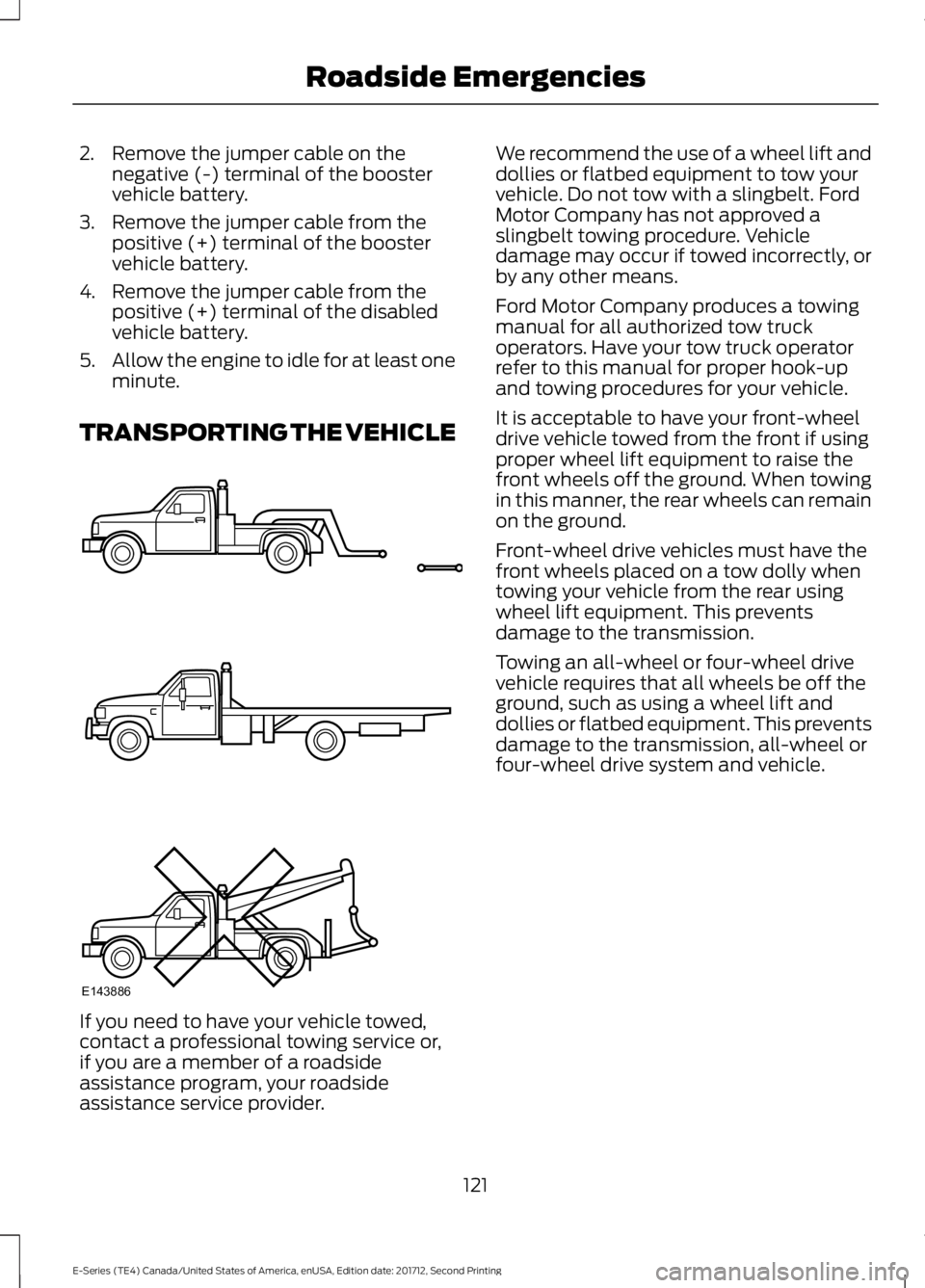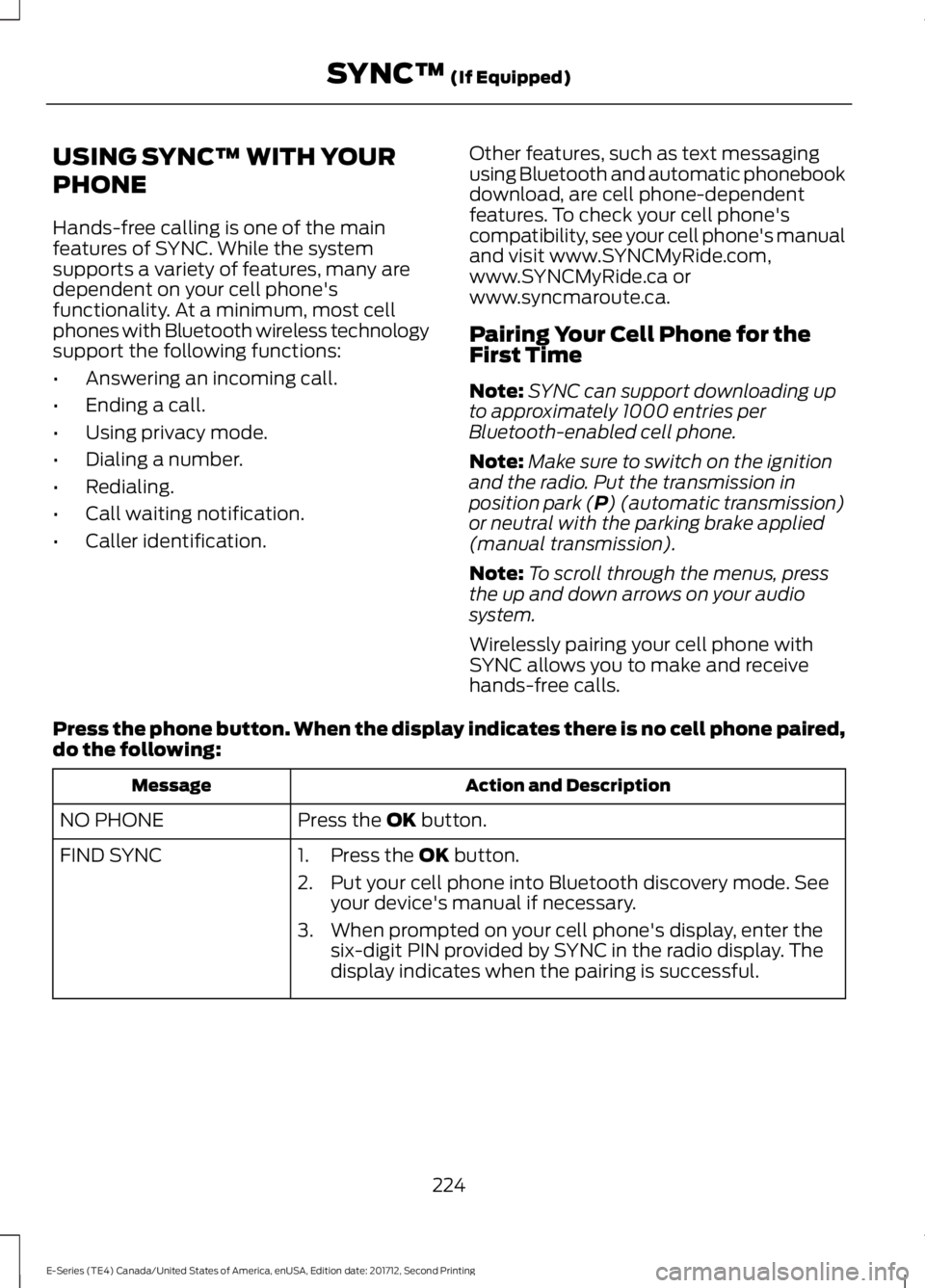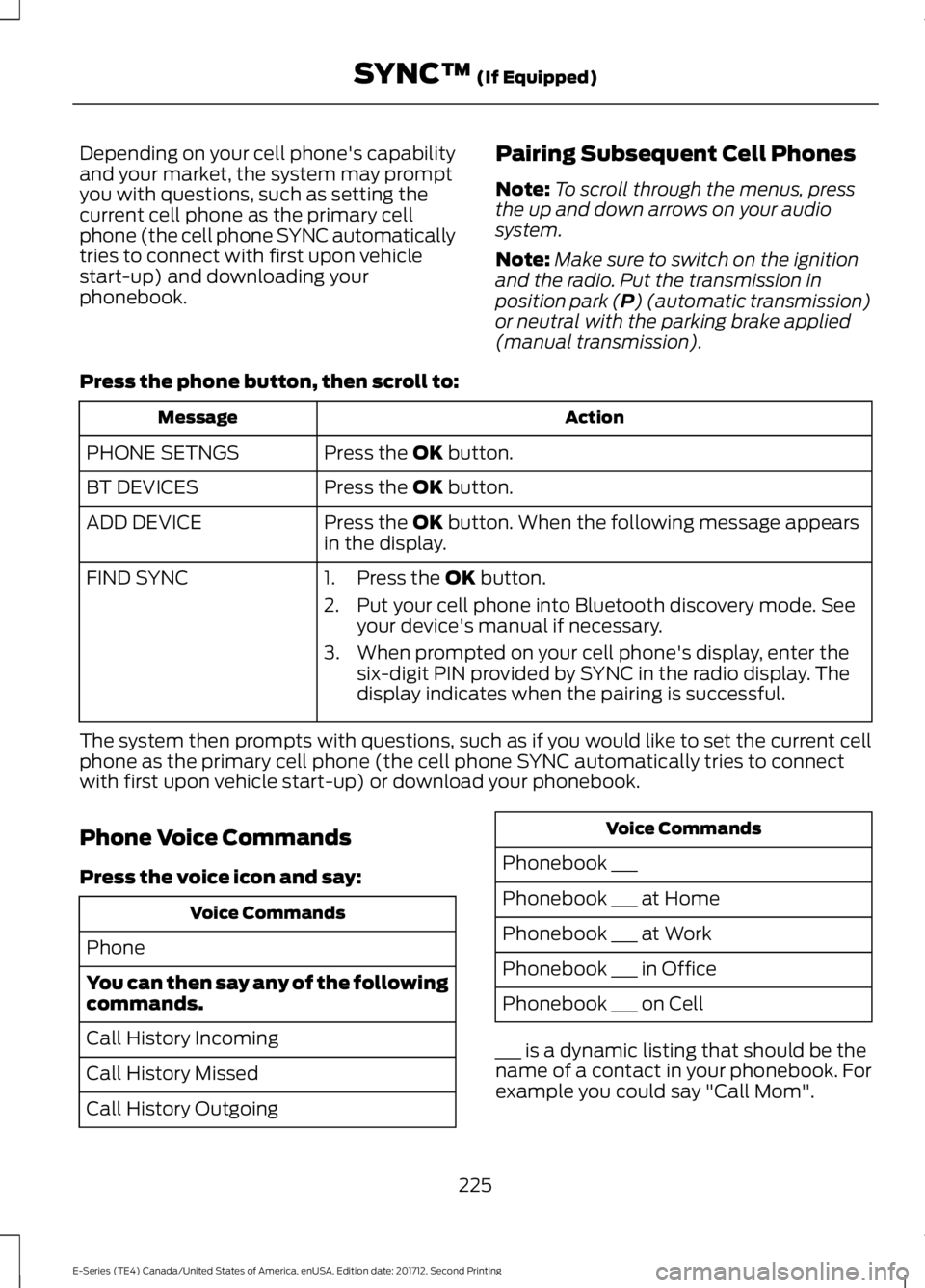2018 FORD E-350 manual transmission
[x] Cancel search: manual transmissionPage 5 of 323

Audible Warnings and Indicators
............55
Information Displays
General Information .....................................
56
Information Messages .................................
61
Climate Control
Manual Climate Control .............................
64
Hints on Controlling the Interior Climate ........................................................................\
..
65
Rear Passenger Climate Controls ...........
66
Seats
Sitting in the Correct Position ..................
68
Head Restraints .............................................
68
Manual Seats .................................................
69
Power Seats ....................................................
69
Auxiliary Power Points
Auxiliary Power Points ..................................
71
Starting and Stopping the Engine
General Information .....................................
73
Ignition Switch ................................................
73
Starting a Gasoline Engine .........................
73
Engine Block Heater .....................................
75
Fuel and Refueling
Safety Precautions .......................................
76
Fuel Quality - E85 .........................................
76
Fuel Quality - Gasoline ................................
78
Running Out of Fuel .....................................
78
Refueling ...........................................................
79
Fuel Consumption ........................................
80
Engine Emission Control
Emission Law ..................................................
82
Catalytic Converter .......................................
83Transmission
Automatic Transmission
............................
86
Rear Axle
Limited Slip Differential .............................
89
Brakes
General Information ....................................
90
Hints on Driving With Anti-Lock Brakes ........................................................................\
..
90
Parking Brake ...................................................
91
Traction Control
Principle of Operation .................................
92
Using Traction Control ................................
92
Parking Aids
Rear View Camera ........................................
93
Cruise Control
Principle of Operation .................................
95
Using Cruise Control ....................................
95
Driving Aids
Steering ............................................................
96
Load Carrying
Load Limit ........................................................
97
Towing
Towing a Trailer ............................................
102
Trailer Sway Control ...................................
103
Recommended Towing Weights ...........
103
Essential Towing Checks ..........................
107
Towing the Vehicle on Four Wheels ......
113
Driving Hints
Breaking-In ......................................................
114
Reduced Engine Performance .................
114
2
E-Series (TE4) Canada/United States of America, enUSA, Edition date: 201712, Second Printing Table of Contents
Page 14 of 323

On Board Diagnostics Data Link
Connector
WARNING
Do not connect wireless plug-in
devices to the data link connector.
Unauthorized third parties could gain
access to vehicle data and impair the
performance of safety related systems.
Only allow repair facilities that follow our
service and repair instructions to connect
their equipment to the data link connector. Your vehicle has an OBD Data Link
Connector (DLC) that is used in
conjunction with a diagnostic scan tool for
vehicle diagnostics, repairs and
reprogramming services. Installing an
aftermarket device that uses the DLC
during normal driving for purposes such as
remote insurance company monitoring,
transmission of vehicle data to other
devices or entities, or altering the
performance of the vehicle, may cause
interference with or even damage to
vehicle systems. We do not recommend
or endorse the use of aftermarket plug-in
devices unless approved by Ford. The
vehicle Warranty will not cover damage
caused by an aftermarket plug-in device.
Notice to Owners of Pickup Trucks
and Utility Type Vehicles
WARNING
Utility vehicles have a significantly
higher rollover rate than other types
of vehicles.
Before you drive your vehicle, please read
this Owner
’s Manual carefully. Your vehicle
is not a passenger car. As with other
vehicles of this type, failure to operate this
vehicle correctly may result in loss of
vehicle control, vehicle rollover, personal
injury or death. Using your Vehicle as an
Ambulance
If your light truck has the Ford Ambulance
Preparation Package, it may be utilized as
an ambulance. Ford urges ambulance
manufacturers to follow the
recommendations of the Ford Incomplete
Vehicle Manual, Ford Truck Body Builder
’s
Layout Book and the Qualified Vehicle
Modifiers (QVM) Guidelines as well as
pertinent supplements. For additional
information, please contact the Truck Body
Builders Advisory Service at
http://www.fleet.ford.com/truckbbas/
and then by selecting Contact Us or by
phone at 1–877 –840–4338.
Use of your Ford light truck as an
ambulance, without the Ford Ambulance
Preparation Package voids the Ford New
Vehicle Limited Warranty and may void
the emissions warranties. In addition,
ambulance usage without the preparation
package could cause high underbody
temperatures, over-pressurized fuel and a
risk of spraying fuel, which could lead to
fires.
If your vehicle has the Ford Ambulance
Preparation Package, it will be indicated
on the Safety Compliance Certification
Label. The label is on the driver side door
pillar or on the rear edge of the driver door.
You can determine whether the
ambulance manufacturer followed Ford ’s
recommendations by directly contacting
that manufacturer.
11
E-Series (TE4) Canada/United States of America, enUSA, Edition date: 201712, Second Printing Introduction
Page 105 of 323

TOWING A TRAILER
WARNINGS
Do not exceed the GVWR or
the GAWR specified on the
certification label. Towing trailers beyond the
maximum recommended
gross trailer weight exceeds the
limit of your vehicle and could
result in engine damage,
transmission damage, structural
damage, loss of vehicle control,
vehicle rollover and personal
injury. Your vehicle may have electrical
items, for example fuses or relays,
related to towing. See Fuses
(page 129).
Your vehicle's load capacity
designation is by weight, not by
volume, so you cannot necessarily
use all available space when
loading your vehicle.
Towing a trailer places an extra
load on your vehicle's engine,
transmission, axle, brakes, tires
and suspension. Inspect these
components periodically during,
and after, any towing operation. Load Placement
To help minimize how trailer
movement affects your vehicle
when driving:
•
Load the heaviest items closest
to the trailer floor.
• Load the heaviest items
centered between the left and
right side trailer tires.
• Load the heaviest items above
the trailer axles or just slightly
forward toward the trailer
tongue. Do not allow the final
trailer tongue weight to go
above or below 10-15% of the
loaded trailer weight.
• Select a draw bar with the
correct rise or drop. When both
the loaded vehicle and trailer
are connected, the trailer frame
should be level, or slightly
angled down toward your
vehicle, when viewed from the
side.
When driving with a trailer or
payload, a slight takeoff vibration
or shudder may be present due to
the increased payload weight.
Additional information regarding
correct trailer loading and setting
your vehicle up for towing is
located in another chapter of this
Owner's Manual. See
Load Limit
(page 97). You can also find the
information in the RV & Trailer
Towing Guide. See an authorized
dealer.
102
E-Series (TE4) Canada/United States of America, enUSA, Edition date: 201712, Second Printing Towing
Page 124 of 323

2. Remove the jumper cable on the
negative (-) terminal of the booster
vehicle battery.
3. Remove the jumper cable from the positive (+) terminal of the booster
vehicle battery.
4. Remove the jumper cable from the positive (+) terminal of the disabled
vehicle battery.
5. Allow the engine to idle for at least one
minute.
TRANSPORTING THE VEHICLE If you need to have your vehicle towed,
contact a professional towing service or,
if you are a member of a roadside
assistance program, your roadside
assistance service provider. We recommend the use of a wheel lift and
dollies or flatbed equipment to tow your
vehicle. Do not tow with a slingbelt. Ford
Motor Company has not approved a
slingbelt towing procedure. Vehicle
damage may occur if towed incorrectly, or
by any other means.
Ford Motor Company produces a towing
manual for all authorized tow truck
operators. Have your tow truck operator
refer to this manual for proper hook-up
and towing procedures for your vehicle.
It is acceptable to have your front-wheel
drive vehicle towed from the front if using
proper wheel lift equipment to raise the
front wheels off the ground. When towing
in this manner, the rear wheels can remain
on the ground.
Front-wheel drive vehicles must have the
front wheels placed on a tow dolly when
towing your vehicle from the rear using
wheel lift equipment. This prevents
damage to the transmission.
Towing an all-wheel or four-wheel drive
vehicle requires that all wheels be off the
ground, such as using a wheel lift and
dollies or flatbed equipment. This prevents
damage to the transmission, all-wheel or
four-wheel drive system and vehicle.
121
E-Series (TE4) Canada/United States of America, enUSA, Edition date: 201712, Second Printing Roadside EmergenciesE143886
Page 155 of 323

4. Turn the A/C on and allow the engine
to idle for at least one minute.
5. Fully press the foot brake. Release the parking brake. Shift the gearshift lever
to Drive (D) and allow the engine to
idle for at least one minute.
6. Drive the vehicle for approximately 10 mi (16 km) to complete the
relearning process.
Note: If you do not carry out the above
process, the idle quality of your vehicle may
be adversely affected until the idle trim is
eventually relearned.
Flexible fuel vehicles operating on E85 may
experience poor starts and driveability
problems until the fuel trim and ethanol
content have been relearned.
When the battery is disconnected or a new
battery installed, the transmission must
learn its adaptive strategy. As a result of
this, the transmission may shift firmly. This
operation is considered normal and fully
updates transmission operation to its
optimum shift feel. We recommend that
the negative battery cable terminal be
disconnected from the battery if you plan
to store your vehicle for an extended period
of time. This minimizes the discharge of
your battery during storage.
Dual Batteries
(If Equipped)
Your vehicle may be fitted with a
frame-mounted battery located on the
passenger side frame rail, behind the front
passenger door. This battery is connected
in parallel with the battery in the engine
compartment. Both batteries are used to
start the vehicle. CHECKING THE WIPER
BLADES
Run the tip of your fingers over the edge of
the blade to check for roughness.
Clean the wiper blades with washer fluid
or water applied with a soft sponge or
cloth.
CHANGING THE WIPER
BLADES
You can manually move the wiper arms
when the ignition is off. This allows for ease
of blade replacement and cleaning under
the blades.
1. Pull the wiper blade and arm away
from the glass.
152
E-Series (TE4) Canada/United States of America, enUSA, Edition date: 201712, Second Printing MaintenanceE142463 E165804
Page 227 of 323

USING SYNC™ WITH YOUR
PHONE
Hands-free calling is one of the main
features of SYNC. While the system
supports a variety of features, many are
dependent on your cell phone's
functionality. At a minimum, most cell
phones with Bluetooth wireless technology
support the following functions:
•
Answering an incoming call.
• Ending a call.
• Using privacy mode.
• Dialing a number.
• Redialing.
• Call waiting notification.
• Caller identification. Other features, such as text messaging
using Bluetooth and automatic phonebook
download, are cell phone-dependent
features. To check your cell phone's
compatibility, see your cell phone's manual
and visit www.SYNCMyRide.com,
www.SYNCMyRide.ca or
www.syncmaroute.ca.
Pairing Your Cell Phone for the
First Time
Note:
SYNC can support downloading up
to approximately 1000 entries per
Bluetooth-enabled cell phone.
Note: Make sure to switch on the ignition
and the radio. Put the transmission in
position park (P) (automatic transmission)
or neutral with the parking brake applied
(manual transmission).
Note: To scroll through the menus, press
the up and down arrows on your audio
system.
Wirelessly pairing your cell phone with
SYNC allows you to make and receive
hands-free calls.
Press the phone button. When the display indicates there is no cell phone paired,
do the following: Action and Description
Message
Press the
OK button.
NO PHONE
FIND SYNC 1. Press the
OK button.
2. Put your cell phone into Bluetooth discovery mode. See your device's manual if necessary.
3. When prompted on your cell phone's display, enter the six-digit PIN provided by SYNC in the radio display. The
display indicates when the pairing is successful.
224
E-Series (TE4) Canada/United States of America, enUSA, Edition date: 201712, Second Printing SYNC™
(If Equipped)
Page 228 of 323

Depending on your cell phone's capability
and your market, the system may prompt
you with questions, such as setting the
current cell phone as the primary cell
phone (the cell phone SYNC automatically
tries to connect with first upon vehicle
start-up) and downloading your
phonebook.
Pairing Subsequent Cell Phones
Note:
To scroll through the menus, press
the up and down arrows on your audio
system.
Note: Make sure to switch on the ignition
and the radio. Put the transmission in
position park (P) (automatic transmission)
or neutral with the parking brake applied
(manual transmission).
Press the phone button, then scroll to: Action
Message
Press the
OK button.
PHONE SETNGS
Press the
OK button.
BT DEVICES
Press the
OK button. When the following message appears
in the display.
ADD DEVICE
FIND SYNC
1. Press the
OK button.
2. Put your cell phone into Bluetooth discovery mode. See your device's manual if necessary.
3. When prompted on your cell phone's display, enter the six-digit PIN provided by SYNC in the radio display. The
display indicates when the pairing is successful.
The system then prompts with questions, such as if you would like to set the current cell
phone as the primary cell phone (the cell phone SYNC automatically tries to connect
with first upon vehicle start-up) or download your phonebook.
Phone Voice Commands
Press the voice icon and say: Voice Commands
Phone
You can then say any of the following
commands.
Call History Incoming
Call History Missed
Call History Outgoing Voice Commands
Phonebook ___
Phonebook ___ at Home
Phonebook ___ at Work
Phonebook ___ in Office
Phonebook ___ on Cell
___ is a dynamic listing that should be the
name of a contact in your phonebook. For
example you could say "Call Mom".
225
E-Series (TE4) Canada/United States of America, enUSA, Edition date: 201712, Second Printing SYNC™
(If Equipped)
Page 316 of 323

A
A/C
See: Climate Control.......................................... 64
About This Manual...........................................5
ABS See: Brakes............................................................. 90
ABS driving hints See: Hints on Driving With Anti-Lock
Brakes................................................................. 90
Accessories....................................................265 Exterior Style....................................................... 265
Interior Style........................................................ 265
Peace of Mind..................................................... 265
Accessories See: Replacement Parts
Recommendation............................................ 10
Adjusting the Headlamps..........................153 Vertical Aim Adjustment Procedure............153
Adjusting the Steering Wheel....................45
Airbag Disposal...............................................36
Air Conditioning See: Climate Control.......................................... 64
Air Filter See: Changing the Engine Air Filter.............158
Appendices....................................................288
At a Glance........................................................14
Audible Warnings and Indicators.............55 Fail-Safe Cooling Warning Chime.................. 55
Headlamps On Warning Chime...................... 55
Key in Ignition Warning Chime........................ 55
Parking Brake On Warning Chime.................. 55
Shift to Park Warning Chime........................... 55
Audio System
...............................................209
General Information......................................... 209
Audio Unit - Vehicles With: AM/FM/CD/ SYNC..............................................................210
Audio Unit - Vehicles With: AM/FM.......212
Automatic Transmission
.............................86
Brake-Shift Interlock........................................... 87
If Your Vehicle Gets Stuck In Mud or Snow.................................................................... 88
Putting your vehicle in or out of gear:...........86
Automatic Transmission Fluid Check.............................................................146
Automatic Transmission Fluid Filter...........149
Checking Automatic Transmission Fluid..................................................................... 147Auxiliary Power Points
...................................71
110 Volt AC Power Point...................................... 71
12 Volt DC Power Point........................................ 71
Locations.................................................................. 71
Auxiliary Switches
.......................................266
B
Battery See: Changing the 12V Battery....................... 151
Bonnet Lock See: Opening and Closing the Hood...........139
Booster Seats
..................................................20
Types of Booster Seats....................................... 21
Brake Fluid Check.........................................149
Brakes................................................................90 General Information........................................... 90
Breaking-In.......................................................114
Bulb Specification Chart...........................156
C
California Proposition 65...............................9
Capacities and Specifications - 6.2L
.................................................................199
Alternative Engine Oil for Extremely Cold
Climates........................................................... 203
Specifications..................................................... 200
Capacities and Specifications - 6.8L
................................................................203
Alternative Engine Oil for Extremely Cold
Climates........................................................... 208
Specifications..................................................... 205
Capacities and Specifications.................194
Car Wash See: Cleaning the Exterior............................... 159
Catalytic Converter........................................83 On-Board Diagnostics (OBD-II)..................... 84
Readiness for Inspection and Maintenance (I/M) Testing..................................................... 84
Changing a Bulb............................................154 Lamp Assembly Condensation..................... 154
Replacing Brake/Tail/Turn/Reverse Lamp Bulbs (Cut-Away Only)............................... 156
Replacing Front Parking Lamp and Direction Indicator Bulbs................................................ 155
Replacing Headlamp Bulbs............................ 155
Replacing Side Marker Bulbs......................... 156
313
E-Series (TE4) Canada/United States of America, enUSA, Edition date: 201712, Second Printing Index